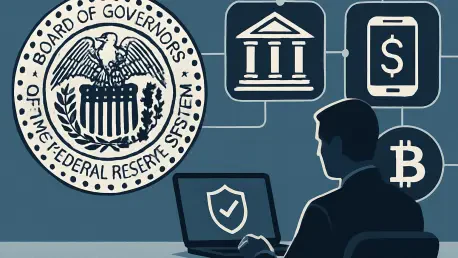I’m thrilled to sit down with Priya Jaiswal, a distinguished expert in banking, business, and finance, whose deep knowledge of market analysis, portfolio management, and international business trends offers invaluable insights into the evolving landscape of financial regulation. Today, we’re diving into the Federal Reserve’s recent decision to discontinue its Novel Activities Supervision Program (NASP), exploring what this means for banks, fintech, and cryptocurrency activities, as well as the broader implications for innovation and risk management in the sector.
Can you walk us through the reasoning behind the Federal Reserve’s decision to end the Novel Activities Supervision Program after just two years?
Certainly, Natalie. The Fed launched NASP in 2023 to specifically oversee banks’ engagement with fintech and crypto activities, which were seen as novel and potentially risky at the time. The decision to end it seems to stem from the Fed’s belief that they’ve gained a solid understanding of these areas over the past two years. They’ve indicated that their grasp of the related risks and bank risk management practices has improved significantly. So, rather than maintaining a separate program, they feel confident integrating this oversight into their standard supervisory framework. It’s likely a move to streamline processes and avoid duplication of efforts now that they’ve built up their expertise.
How do you see this shift—folding crypto and fintech oversight back into regular supervision—affecting banks that are active in these spaces?
I think it’s a bit of a double-edged sword. On one hand, integrating oversight into the standard process could simplify things for banks, as they won’t have to navigate a separate set of rules or reporting structures for novel activities. It might reduce some administrative burden. On the other hand, there’s a risk that without a dedicated program like NASP, the unique challenges and fast-evolving nature of fintech and crypto might not get the focused attention they need. Banks could face less tailored guidance, which might make it harder to innovate safely or could expose them to unforeseen risks if standard supervision isn’t fully adapted to these areas yet.
What was the original vision for NASP when it was introduced, and how did the Fed aim to strike a balance between innovation and safety?
The vision for NASP was quite forward-thinking. When it was created in 2023, the Fed wanted to encourage financial innovation while ensuring the safety and soundness of the banking system. The idea was to provide a structured way to supervise banks engaging in novel activities like distributed ledger technology, crypto, and fintech partnerships. They aimed to balance innovation and safety by building technical expertise within the Fed, understanding the unique risks of these activities, and developing appropriate controls. Essentially, NASP was meant to be a sandbox for learning and refining how to oversee cutting-edge financial practices without stifling progress.
With the Fed mentioning a strengthened understanding of crypto and fintech risks, can you elaborate on what specific risks they might have learned about through NASP?
Absolutely. Over the two years of NASP, the Fed likely deepened its understanding of several key risks. For crypto, volatility is a huge concern—both in terms of asset prices and regulatory uncertainty. There’s also the issue of cybersecurity, as digital assets are prime targets for hacks and fraud. In fintech, risks often revolve around operational dependencies, like when banks rely on third-party tech providers who might not have the same level of oversight or resilience. Consumer protection is another big one, ensuring that innovative products don’t mislead or harm users. Through NASP, the Fed probably got a clearer picture of how these risks manifest in real-world banking scenarios and how banks can—or sometimes fail to—manage them effectively.
There’s been talk about the alignment of this decision with broader political support for artificial intelligence under the current administration. How do you think AI innovation in banking might be influenced by the end of NASP?
That’s an interesting connection. While the Fed hasn’t explicitly tied the NASP decision to AI policy, the broader push for AI under the current administration could play a role indirectly. AI is becoming a cornerstone of bank and fintech innovation, from fraud detection to personalized customer services. Folding NASP into general supervision might signal a more integrated approach to emerging tech, including AI, rather than siloing different innovations. This could potentially give banks more flexibility to experiment with AI without a specialized oversight program breathing down their necks. However, it also means the Fed needs to ensure its general supervisory staff are well-versed in AI-specific risks, like algorithmic bias or data privacy issues, to avoid gaps in oversight.
There’s a perspective from industry leaders about the importance of educating Fed examiners on emerging technologies. How critical do you think this is for effective supervision moving forward?
It’s absolutely essential. Emerging technologies like crypto, AI, and fintech solutions evolve at a breakneck pace, and the risks they pose are often unlike anything traditional banking supervision has dealt with. If examiners aren’t up to speed, they might miss critical red flags or misjudge the safety of a bank’s innovative practices. Education ensures that supervision isn’t just a box-checking exercise but a meaningful assessment of risk. The Fed should prioritize ongoing training, collaborate with industry experts, and perhaps even embed tech specialists within supervisory teams to keep pace with these developments. Without that, integrating NASP into general oversight could fall flat.
Looking at the bigger picture, how do you think discontinuing NASP might impact innovation within the banking sector?
I believe the impact could go either way, depending on execution. On the positive side, removing a separate supervisory program might reduce perceived regulatory hurdles, encouraging banks to dive into innovative projects with less fear of specialized scrutiny. It could foster a more dynamic environment for fintech and crypto adoption. However, if general supervision isn’t equipped to handle the nuances of novel activities, banks might hesitate to innovate due to uncertainty or fear of missteps that could draw penalties. The key will be whether the Fed can maintain the depth of understanding and focus that NASP provided, even within a broader framework. Without that, we might see a slowdown in responsible innovation.
What is your forecast for the future of fintech and crypto oversight in banking now that NASP is no longer a standalone program?
Looking ahead, I think we’re entering a phase of integration and adaptation. The Fed’s decision to fold NASP into standard supervision suggests they’re aiming for a more holistic approach, treating fintech and crypto as part of the broader banking landscape rather than isolated novelties. I expect we’ll see evolving guidelines and possibly new tools within the general supervisory framework to address these areas. However, the pace of technological change will test this model. If the Fed can keep examiners educated and responsive, oversight could become more seamless and supportive of innovation. But if they lag, we might see calls for another specialized program down the line. The next few years will be crucial in showing whether this integrated approach can balance risk and progress effectively.









